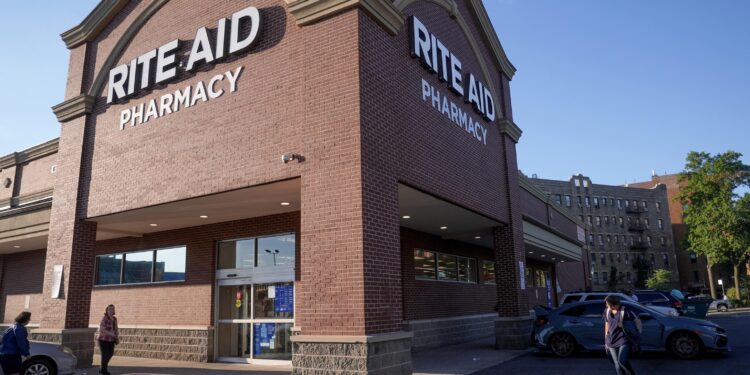In a striking development that reverberates through the corridors of American healthcare, Rite Aid’s recent declaration of bankruptcy serves as a stark warning about the fragility of the nation’s health service landscape. Once a prominent player in the pharmacy sector, Rite Aid’s struggles underscore deeper systemic issues that threaten to unravel the fabric of accessible, affordable healthcare for millions of Americans. As the company navigates this financial upheaval, experts caution that its downfall is not merely a corporate failure but rather a reflection of larger, more troubling trends within the healthcare system. From rising costs and shifting market dynamics to the impact of legislative changes, Rite Aid’s situation encapsulates pressing concerns that, if left unaddressed, could impact the availability and quality of medical services nationwide. This article delves into the factors behind Rite Aid’s bankruptcy and explores what it reveals about the current state of American healthcare.
The Ripple Effect of Rite Aid’s Bankruptcy on Pharmacy Accessibility
The fallout from Rite Aid’s bankruptcy extends beyond the company’s balance sheets; it threatens to exacerbate the existing issues regarding pharmacy accessibility across the United States. As one of the largest pharmacy chains, Rite Aid’s closure or reduction in service capabilities could lead to a significant healthcare gap, particularly in underserved communities. Reports indicate that many areas relying on Rite Aid for prescription fulfillment and health consultations may experience longer wait times for medications, transportation challenges for those without easy access to alternative pharmacies, and an overall decrease in pharmaceutical services available to residents. The risk of pharmacy deserts looms larger, whereby patients are unable to reach essential medications or health consultations, ultimately jeopardizing their well-being.
Moreover, the bankruptcy could adversely affect the pricing structure of medications in the market. With fewer competitors, pharmacies’ ability to negotiate drug prices could diminish, leading to inflated costs that disproportionately affect low-income families. A closer examination reveals potential trends, such as:
- Increased Drug Prices: A decline in competition may result in higher prices for essential medications.
- Limited Availability: Fewer pharmacies may lead to stock shortages of crucial medications.
- Job Losses: Layoffs at Rite Aid and environments where pharmacies close could increase unemployment in already struggling areas.
In light of these developments, stakeholders must recognize the interconnectedness of pharmacy operations and broader healthcare access. The implications of Rite Aid’s struggles highlight a need for systemic changes in the healthcare sector that prioritize patient accessibility and affordability.
Examining the Financial Strains Facing Community Health Services
The recent bankruptcy of Rite Aid serves as a critical reminder of the financial limitations that community health services face across the United States. Many of these local healthcare providers are grappling with escalating operational costs and shrinking reimbursements. The collapse of a major pharmacy chain not only highlights the vulnerabilities within the retail segment of health care but also underscores the broader implications for community health services. These institutions have become lifelines for many underserved populations, often providing essential services such as medication management, preventative care, and health education. However, their financial sustainability is increasingly jeopardized by factors including:
- Rising Drug Costs
- Decreased Medicaid Reimbursements
- Increased Competition from Online Pharmacies
- Labor Shortages and Wage Inflation
Moreover, the consequences of such financial strains can be far-reaching. As community health services struggle to stay afloat, access to care in low-income neighborhoods becomes threatened. This could potentially lead to increased hospital admissions and higher overall healthcare costs as treatable conditions go unmanaged. To effectively combat these challenges and ensure that community health services can continue to operate, stakeholders must consider a variety of strategies, such as advocating for policy reforms, fostering partnerships with local organizations, and leveraging technology to enhance service delivery. A proactive approach is essential in reshaping the economic landscape of community health care.
| Key Challenges | Potential Solutions |
|---|---|
| Rising Operational Costs | Cost Management Strategies |
| Decreased Funding | Advocacy for Increased Public Funding |
| Access to Care Issues | Community Outreach Programs |
| Workforce Shortage | Incentives for Healthcare Workers |
Strategies for Strengthening Americas Healthcare Infrastructure Amidst Market Uncertainty
The recent bankruptcy filing by Rite Aid serves as a stark reminder of the vulnerabilities plaguing the American healthcare system, compelling stakeholders to consider robust strategies to fortify its infrastructure. Key among these strategies is the enhancement of pharmacy services, which are integral to patient care. By integrating pharmacies more closely into healthcare delivery systems, providers can ensure better access to medications while reducing overall healthcare costs. Investments in telehealth platforms can also maximize outreach, providing critical services to underserved communities, thereby bridging gaps in patient access and continuity of care.
Additionally, fostering collaboration across sectors can yield innovative solutions that address both systemic inefficiencies and market fluctuations. Strategic partnerships between public and private entities can enhance resource allocation and operational resilience. This could include developing shared care pathways that ensure seamless transitions between various healthcare settings. Moreover, focusing on workforce development through training and retention programs will be vital as healthcare faces ongoing challenges, such as staffing shortages and increasing demand for services. As the landscape of American healthcare evolves, prioritizing these multifaceted approaches will be essential in navigating uncertainty and preserving quality care for all citizens.
Insights and Conclusions
As Rite Aid navigates the complexities of bankruptcy, its situation serves as a critical flashpoint in the broader dialogue about the state of American health care. The challenges faced by the pharmacy giant underscore systemic issues, including rising operational costs, market competition, and an evolving landscape of health care consumerism. This is not merely a corporate story; it is a cautionary tale that reflects the struggles of an entire industry grappling with sustainability and access to essential services.
In the coming months, the implications of Rite Aid’s financial woes will reverberate, impacting employees, health care providers, and patients alike. As stakeholders assess the future of the company and its role in the health care ecosystem, it is imperative that policymakers also take heed. Addressing the vulnerabilities exposed by Rite Aid’s challenges will be crucial in ensuring a more resilient and equitable health care system moving forward.
In essence, Rite Aid’s bankruptcy is more than a corporate setback; it serves as a stark reminder of the urgent need for reform within American health care—a call to action for those who aim to safeguard public health in an increasingly uncertain environment.


























![[WEBINAR] Perceptions of Prosperity: Californians and Americans Assess Where They Stand in a Changing Economy – Ipsos](https://earth-news.info/wp-content/uploads/2025/11/324518-webinar-perceptions-of-prosperity-californians-and-americans-assess-where-they-stand-in-a-changing-economy-ipsos-120x86.jpg)



